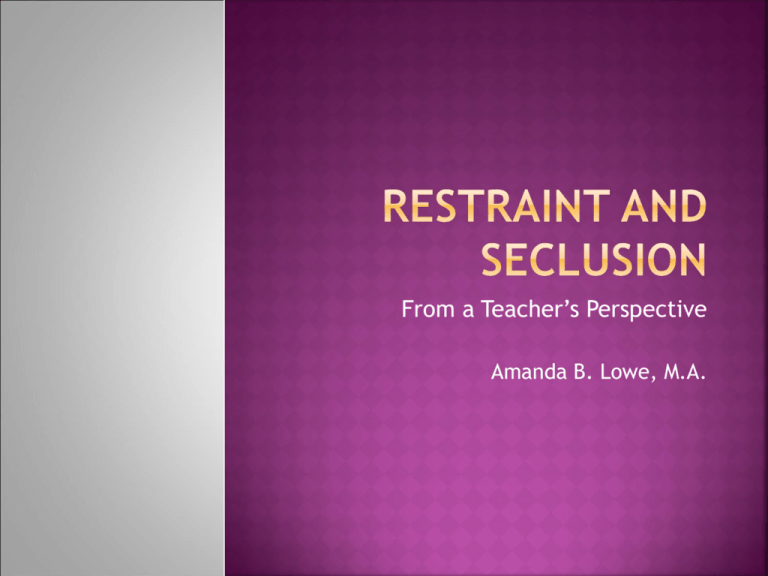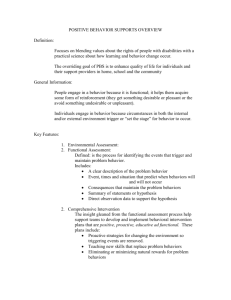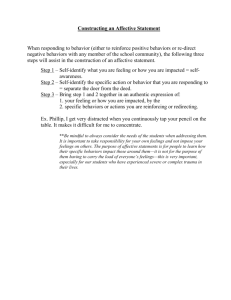Seclusion and Restraint Part 2
advertisement

From a Teacher’s Perspective Amanda B. Lowe, M.A. How adults feed into a student’s oppositional behavior. Behavior management techniques that really work! Putting it all together school wide Positive Behavior Supports (PBS) If you have to use a restraint… What NASDSE is doing at the federal level "Good teaching cannot be reduced to technique; good teaching comes from the identity and integrity of the teacher." -Parker Palmer, “The Courage to Teach” Describes how oppositional students create counter aggressive feelings in staff which often leads to a mutual, self-defeating power struggle and reinforce the student’s irrational beliefs (become a self fulfilling prophecy). Nick Long, 1996. A stressful incident occurs which ACTIVATES a troubled student’s irrational beliefs. These negative thoughts determine and trigger his feelings. His feelings and not his rational forces DRIVE his inappropriate behavior. His inappropriate behaviors INCITE adults. Adults not only pick up the student’s feelings, but also they frequently MIRROR his behaviors. This negative adult REACTION increases the student’s stress escalating the conflict into a self-defeating power struggle. Although the student may lose the battle (i.e., he is punished), he wins the war! His SELF-FULFILLING PROPHECY (i.e. irrational belief) is REINFORCED and therefore, he has no motivation to change or alter his beliefs or his inappropriate behaviors. Long, N.J. (1996). The conflict cycle paradigm on how troubled students get teachers out of control. In N. Long & W. Morse (Eds.), Conflict in the Classroom: The Education of At-Risk and Troubled Students. P. 224-265 Conflict is a natural and inevitable part of a student’s life. Conflict is neither good nor bad, but a function of the student’s perceptions and thoughts. A student in conflict is his/her own worst enemy. A student in conflict can create in others (adults) his/her feelings. Untrained staff may mirror these feelings. If an adult gets caught in the conflict cycle, the struggle will escalate and there are no winners. Some techniques you will use consistently (expectations, explicit directions, etc). Others you will use when you need them (planned ignoring, proximity control, etc). Classroom Created jointly, stated positively, repeated daily. Support from Routine Use a daily schedule, agenda, time limits, etc. Permitting Instructions Let your students know exactly what is expected of them, and if they are unsure, exactly how to achieve the goal. Planned Behavior Decide what behaviors, while not ideal, are permissible. Explicit Expectations Ignoring If possible, ignore minor misbehavior – don’t reinforce it with your attention. Proximity Control Move close to your student, putting a hand on a shoulder, etc. Signaling Give non-verbal feedback on behavior i.e., a shake of the head, a thumbs up. Antiseptic Give your student a valid reason to leave the classroom before escalation occurs. Limited Bounce Choices Give your student a valid reason to leave the classroom before escalation occurs (purple crayon example). Surprise Never underestimate the power of surprise in holding students attention! A bored student is an unpredictable student. Removal of Seductive Objects Remove objects that appear to be interfering with student’s behavior. Shaping Reinforce behavior that approximates desired behavior. Modeling Constantly practice student behaviors you wish to increase as part of your teaching repertoire. Ripple Effect Praise and reward students who are exhibiting appropriate behavior – you will be amazed at the power of this on others!! Positive Reinforcement Praise and reward your students!!! Celebrate their successes! Move from extrinsic rewards to intrinsic rewards. PBS is a school-wide model that supports the academic and behavioral needs of ALL students. The PBS model utilizes all school personnel from teachers to related service personnel to bus drivers. PBS emphasizes four integrated elements: (a) data for decision making; (b) measurable outcomes supported and evaluated by data; (c) practices with evidence that these outcomes are achievable and; (d) systems that efficiently and effectively support implementation of these practices. www.pbis.org Make sure you are trained and certified. Know your school policy. If you have questions, ask, ask, ask… Self assess motivation. Be sure of imminent danger to self(student) or others. Use the least restrictive hold. Do not become emotionally involved. Process with student following restraint. Notify all proper individuals. Document. Currently meeting with education and disability groups to craft common language for expected legislation. Working with House and Senate staff on language for expected legislation. Publically supports introduced legislation that promotes PBS. Long, N. J., & Morse, W. C. (1996). Conflict in the classroom: The education of at-risk and troubled students. Austin, TX: Pro-ed. Mendler, A.N, & Curwin R.L. (1999) Discipline with dignity for challenging youth. Bloomington, IN: National Educational Service. Long, N., & Long, J. (2002) Angry Smiles. Bloomington, IN: National Education Service. Brendtro, L. K., Brokenleg, M., & Van Bockern, S. (2001). Reclaiming youth at risk: Our hope for the future. Bloomington, IN: National Educational Service. www.pbis.org http://www.lsci.org/welcome http://cecp.air.org/ http://www.nasponline.org/resources/factsh eets/pbs_fs.aspx http://www.aft.org/pubsreports/teachers/CT-BehaviorMgmt.pdf




